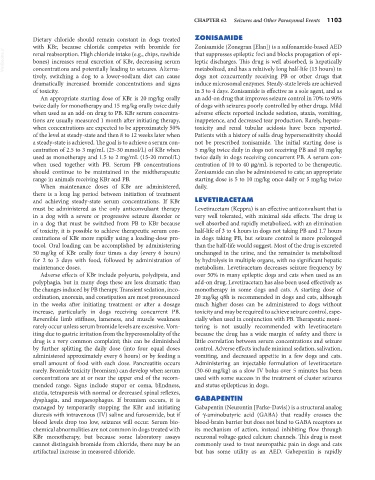Page 1131 - Small Animal Internal Medicine, 6th Edition
P. 1131
CHAPTER 62 Seizures and Other Paroxysmal Events 1103
Dietary chloride should remain constant in dogs treated ZONISAMIDE
with KBr, because chloride competes with bromide for Zonisamide (Zonegran [Elan]) is a sulfonamide-based AED
VetBooks.ir renal reabsorption. High chloride intake (e.g., chips, rawhide that suppresses epileptic foci and blocks propagation of epi-
leptic discharges. This drug is well absorbed, is hepatically
bones) increases renal excretion of KBr, decreasing serum
concentrations and potentially leading to seizures. Alterna-
dogs not concurrently receiving PB or other drugs that
tively, switching a dog to a lower-sodium diet can cause metabolized, and has a relatively long half-life (15 hours) in
dramatically increased bromide concentrations and signs induce microsomal enzymes. Steady-state levels are achieved
of toxicity. in 3 to 4 days. Zonisamide is effective as a sole agent, and as
An appropriate starting dose of KBr is 20 mg/kg orally an add-on drug that improves seizure control in 70% to 90%
twice daily for monotherapy and 15 mg/kg orally twice daily of dogs with seizures poorly controlled by other drugs. Mild
when used as an add-on drug to PB. KBr serum concentra- adverse effects reported include sedation, ataxia, vomiting,
tions are usually measured 1 month after initiating therapy, inappetence, and decreased tear production. Rarely, hepato-
when concentrations are expected to be approximately 50% toxicity and renal tubular acidosis have been reported.
of the level at steady-state and then 8 to 12 weeks later when Patients with a history of sulfa drug hypersensitivity should
a steady-state is achieved. The goal is to achieve a serum con- not be prescribed zonisamide. The initial starting dose is
centration of 2.5 to 3 mg/mL (25-30 mmol/L) of KBr when 5 mg/kg twice daily in dogs not receiving PB and 10 mg/kg
used as monotherapy and 1.5 to 2 mg/mL (15-20 mmol/L) twice daily in dogs receiving concurrent PB. A serum con-
when used together with PB. Serum PB concentrations centration of 10 to 40 µg/mL is reported to be therapeutic.
should continue to be maintained in the midtherapeutic Zonisamide can also be administered to cats; an appropriate
range in animals receiving KBr and PB. starting dose is 5 to 10 mg/kg once daily or 5 mg/kg twice
When maintenance doses of KBr are administered, daily.
there is a long lag period between initiation of treatment
and achieving steady-state serum concentrations. If KBr LEVETIRACETAM
must be administered as the only anticonvulsant therapy Levetiracetam (Keppra) is an effective anticonvulsant that is
in a dog with a severe or progressive seizure disorder or very well tolerated, with minimal side effects. The drug is
in a dog that must be switched from PB to KBr because well absorbed and rapidly metabolized, with an elimination
of toxicity, it is possible to achieve therapeutic serum con- half-life of 3 to 4 hours in dogs not taking PB and 1.7 hours
centrations of KBr more rapidly using a loading-dose pro- in dogs taking PB, but seizure control is more prolonged
tocol. Oral loading can be accomplished by administering than the half-life would suggest. Most of the drug is excreted
50 mg/kg of KBr orally four times a day (every 6 hours) unchanged in the urine, and the remainder is metabolized
for 2 to 3 days with food, followed by administration of by hydrolysis in multiple organs, with no significant hepatic
maintenance doses. metabolism. Levetiracetam decreases seizure frequency by
Adverse effects of KBr include polyuria, polydipsia, and over 50% in many epileptic dogs and cats when used as an
polyphagia, but in many dogs these are less dramatic than add-on drug. Levetiracetam has also been used effectively as
the changes induced by PB therapy. Transient sedation, inco- monotherapy in some dogs and cats. A starting dose of
ordination, anorexia, and constipation are most pronounced 20 mg/kg q8h is recommended in dogs and cats, although
in the weeks after initiating treatment or after a dosage much higher doses can be administered to dogs without
increase, particularly in dogs receiving concurrent PB. toxicity and may be required to achieve seizure control, espe-
Reversible limb stiffness, lameness, and muscle weakness cially when used in conjunction with PB. Therapeutic moni-
rarely occur unless serum bromide levels are excessive. Vom- toring is not usually recommended with levetiracetam
iting due to gastric irritation from the hyperosmolality of the because the drug has a wide margin of safety and there is
drug is a very common complaint; this can be diminished little correlation between serum concentrations and seizure
by further splitting the daily dose (into four equal doses control. Adverse effects include minimal sedation, salivation,
administered approximately every 6 hours) or by feeding a vomiting, and decreased appetite in a few dogs and cats.
small amount of food with each dose. Pancreatitis occurs Administering an injectable formulation of levetiracetam
rarely. Bromide toxicity (bromism) can develop when serum (30-60 mg/kg) as a slow IV bolus over 5 minutes has been
concentrations are at or near the upper end of the recom- used with some success in the treatment of cluster seizures
mended range. Signs include stupor or coma, blindness, and status epilepticus in dogs.
ataxia, tetraparesis with normal or decreased spinal reflexes,
dysphagia, and megaesophagus. If bromism occurs, it is GABAPENTIN
managed by temporarily stopping the KBr and initiating Gabapentin (Neurontin [Parke-Davis]) is a structural analog
diuresis with intravenous (IV) saline and furosemide, but if of γ-aminobutyric acid (GABA) that readily crosses the
blood levels drop too low, seizures will occur. Serum bio- blood-brain barrier but does not bind to GABA receptors as
chemical abnormalities are not common in dogs treated with its mechanism of action, instead inhibiting flow through
KBr monotherapy, but because some laboratory assays neuronal voltage-gated calcium channels. This drug is most
cannot distinguish bromide from chloride, there may be an commonly used to treat neuropathic pain in dogs and cats
artifactual increase in measured chloride. but has some utility as an AED. Gabepentin is rapidly

